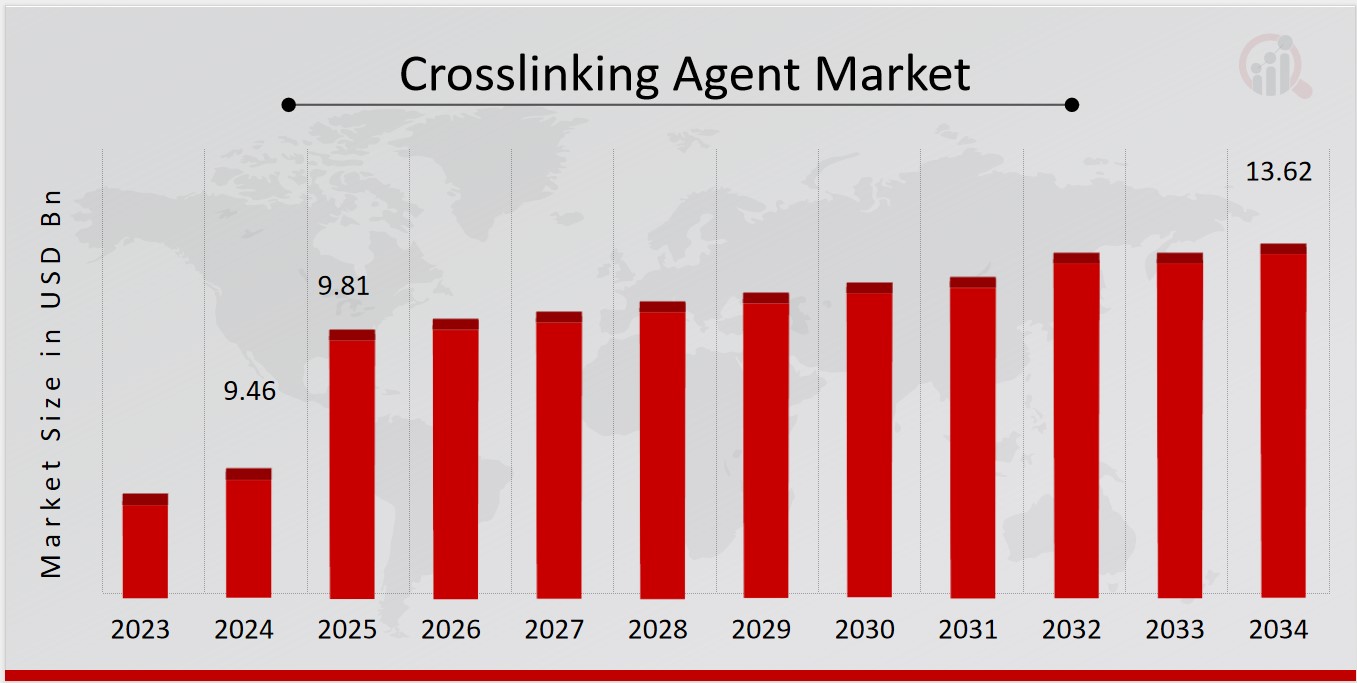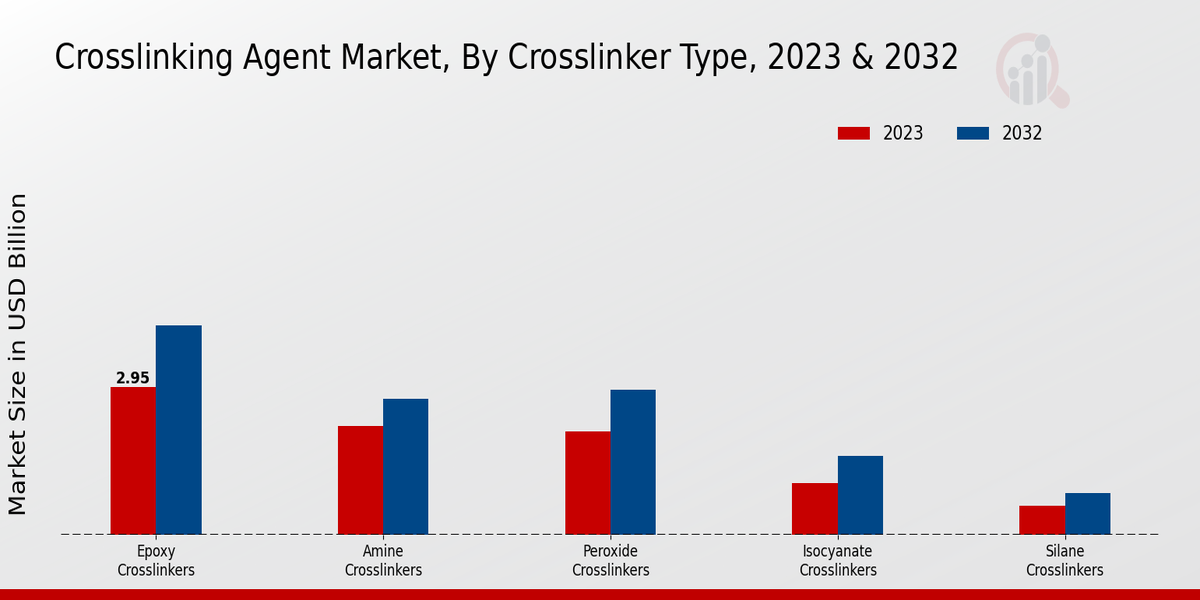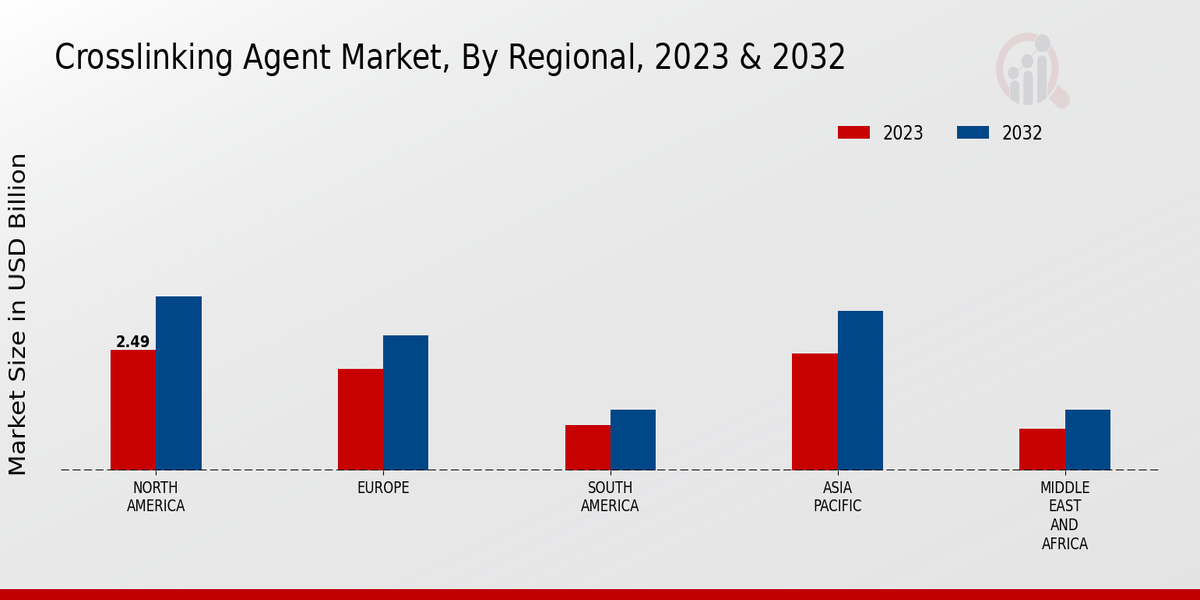Global Crosslinking Agent Market Overview
The Crosslinking Agent Market Size was estimated at 9.46 (USD Billion) in 2024. The Crosslinking Agent Industry is expected to grow from 9.81 (USD Billion) in 2025 to 13.62 (USD Billion) by 2034. The Crosslinking Agent Market CAGR (growth rate) is expected to be around 3.71% during the forecast period (2025 - 2034).
Key Crosslinking Agent Market Trends Highlighted
The market for crosslinking agents is expanding because of the growing need for strong, lightweight materials across a range of industries, including aerospace and automotive.
Through the formation of covalent connections between polymer chains, crosslinking agents improve the strength and durability of materials. Because of this, they are being used more frequently in the creation of coatings, adhesives, and composites.
Furthermore, opportunities are being created for bio-based crosslinking agents by the growing trend towards environmentally friendly and sustainable products.
In response to the increased customer demand for environmentally friendly products, these crosslinking agents—which are made from renewable resources—offer a more environmentally responsible option than conventional ones.
Crosslinking agents with several functions that provide enhanced performance and adaptability are a recent trend in the industry. To the finished product, these agents can give further features like UV resistance or flame retardancy.
In addition, it is anticipated that the growing application of crosslinking agents in additive manufacturing and 3D printing will support market expansion in the upcoming years.

Source: Primary Research, Secondary Research, MRFR Database and Analyst Review
Crosslinking Agent Market Drivers
-
Growing Demand for Crosslinked Polymers
Crosslinking agents are consumed to produce crosslinked polymers, which find a wide range of applications in practice.
They are being used in the automotive, construction, packaging, and other industries, as they possess enhanced properties such as higher strength, durability, and resistance to heat and chemicals.
Crosslinked polymers are used to produce various auto parts, both external and internal, as well as diverse construction materials and protective films used for packaging.
The increasing demand for lightweight, durable materials, which are the high-performance ones as well, from the above-mentioned industries is the primary driver of the crosslinking agent market.
Expansion of the Medical Device Industry
Crosslinking agents are also widely used in the medical device industry to produce medical implants, surgical sutures, and drug delivery systems.
The increasing prevalence of chronic diseases and the growing demand for minimally invasive procedures are contributing to the expansion of the medical device industry.
Crosslinked polymers are used in medical devices due to their biocompatibility, flexibility, and resistance to degradation. The growing demand for medical devices is expected to drive the growth of the crosslinking agent market.
Rising Environmental Concerns
Increasing environmental concerns and regulations are driving the demand for environmentally friendly crosslinking agents.
Traditional crosslinking agents often contain hazardous chemicals that can pose risks to human health and the environment.
The development and use of bio-based and biodegradable crosslinking agents are gaining traction in response to these concerns.
These agents offer a more sustainable alternative to traditional crosslinking agents, reducing the environmental impact of the crosslinking process.
Crosslinking Agent Market Segment Insights
Crosslinking Agent Market Crosslinker Type Insights
Epoxy Crosslinkers, Amine Crosslinkers, Peroxide Crosslinkers, Isocyanate Crosslinkers, and Silane Crosslinkers are the primary crosslinkers utilized in the Crosslinking Agent Market.
Epoxy Crosslinkers also dominate the market share, accounting for around 51.2% in 2023 due to their excellent adhesion properties, resistance to chemicals and good thermal stability.
The Crosslinking Agent Market for Epoxy Crosslinkers is expected to grow from USD 3.16 Billion in 2023 to USD 4.27 Billion by 2032, CAGR of 3.3% from 2024 to 2032 due to demand in industries like automotive, aerospace and construction.
Amine Crosslinkers are the second leading type of crosslinker, occupying 26.5% of the Crosslinking Agent Market by 2023 due to their excellent flexibility and excellent resistance to chemicals and moisture.
The Crosslinking Agent Market for Amine Crosslinkers is anticipated to reach USD 2.21 Billion by 2032, CAGR of 3.5% from 2024 to 2032. This is attributed to their increasing applications in industries like packaging, coatings and adhesives.
Peroxide Crosslinkers, Isocyanate Crosslinkers, and Silane Crosslinkers account for the remaining percentage of the Crosslinking Agent Market.
The market growth for each of the previously mentioned types is to be driven or hindered by factors such as increasing demand in other end use industries and technological advancements.

Source: Primary Research, Secondary Research, MRFR Database and Analyst Review
Crosslinking Agent Market Application Insights
The present report groups the Crosslinking Agent Market by application, delineating Paints and Coatings, Rubber and Plastics, Adhesives and Sealants, Textiles, and Composites segments.
It is important to point out that the Paints and Coatings segment was the largest one in 2023 and will continue to cover the largest part of the market throughout the entire forecast period.
The necessity of high-performance coatings has been facilitating the demand for this type of product in a variety of industrial areas. Specifically, the segment will grow due to the increasing demand in the automotive, construction, and electronics spheres.
The Rubber and Plastics section will also move up significantly as crosslinking agents are becoming more popular in tires, hoses, as well as other rubber and plastics products.
The Adhesives and Sealants, Textiles, and Composites segments will contribute to the overall growth of the Crosslinking Agent Market.
Crosslinking Agent Market End-Use Industry Insights
The Crosslinking Agent Market segmentation by End-Use Industry offers valuable insights into the industry's application landscape. Key segments include Automotive, Construction, Packaging, Electronics, and Medical.
In 2023, the Automotive segment held a significant share of the Crosslinking Agent Market revenue, driven by the rising demand for lightweight and durable materials in vehicle manufacturing. The Construction segment is projected to witness steady growth owing to the increasing use of crosslinking agents in infrastructure development and repair projects.
Packaging applications are expected to propel market expansion as crosslinking agents enhance the barrier properties and shelf life of packaging materials.
Electronics and Medical segments are anticipated to contribute notably to the Crosslinking Agent Market growth due to their growing demand in advanced electronic devices and medical implants respectively.
Crosslinking Agent Market Regional Insights
The regional segmentation of the Crosslinking Agent Market provides insights into the market's geographic distribution and performance. North America is expected to dominate the market in 2023, with a revenue of USD 3.2 billion.
Europe is projected to follow closely with a revenue of USD 2.7 billion, while APAC is anticipated to grow at a CAGR of 4.5% during the forecast period.
South America and MEA are also expected to contribute to the market growth, with revenues of USD 1.2 billion and USD 1.1 billion, respectively, in 2023.
The growth in these regions is attributed to the increasing demand for crosslinking agents in various industries, such as automotive, construction, and electronics.

Source: Primary Research, Secondary Research, MRFR Database and Analyst Review
Crosslinking Agent Market Key Players and Competitive Insights
Major players in the Crosslinking Agent Market are focusing on developing innovative products to meet the evolving needs of customers. Leading Crosslinking Agent Market players are also investing in research and development to improve the performance and efficiency of their products.
The Crosslinking Agent Market development is being driven by the increasing demand for crosslinked polymers in various applications such as automotive, construction, and packaging.
The competitive landscape of the Crosslinking Agent Market is expected to remain fragmented, with a few key players accounting for most of the market share.
Evonik Industries is a leading specialty chemicals company that offers a wide range of crosslinking agents. The company's crosslinking agents are used in a variety of applications, including adhesives, coatings, and plastics.
Evonik Industries has a strong presence with manufacturing facilities in Europe, Asia, and the Americas. The company is committed to providing innovative and sustainable solutions to its customers.
BASF is another major player in the Crosslinking Agent Market. The company's crosslinking agents are used in a variety of applications, including rubber, plastics, and textiles.
BASF has a strong presence with manufacturing facilities in Europe, Asia, and the Americas. The company is focused on developing innovative and sustainable solutions that meet the needs of its customers.
Key Companies in the Crosslinking Agent Market Include
- Evonik
- Dow
- Mitsubishi Chemical
- Toray
- Momentive Performance Materials
- Ashland Specialty Chemicals
- Huntsman
- BASF
- Hexion
- DIC Corporation
- Stepan
- Lanxess
- Perstorp
- ICL
- Sumitomo Chemical
Crosslinking Agent Market Developments
The increasing demand for crosslinking agents in various industries, such as automotive, construction, and packaging, is driving market growth.
The growing adoption of lightweight and high-performance materials in the automotive sector is boosting the demand for crosslinking agents used in adhesives, sealants, and coatings.
Moreover, the rising construction activities worldwide are fueling the demand for crosslinking agents in construction chemicals, including concrete admixtures, flooring compounds, and roofing materials.
Crosslinking Agent Market Segmentation Insights
Crosslinking Agent Market Crosslinker Type Outlook
- Epoxy Crosslinkers
- Amine Crosslinkers
- Peroxide Crosslinkers
- Isocyanate Crosslinkers
- Silane Crosslinkers
Crosslinking Agent Market Application Outlook
- Paints and Coatings
- Rubber and Plastics
- Adhesives and Sealants
- Textiles
- Composites
Crosslinking Agent Market End-Use Industry Outlook
- Automotive
- Construction
- Packaging
- Electronics
- Medical
Crosslinking Agent Market Regional Outlook
- North America
- Europe
- South America
- Asia-Pacific
- Middle East and Africa
|
Report Attribute/Metric
|
Details
|
|
Market Size 2024
|
9.46 (USD Billion)
|
|
Market Size 2025
|
9.81 (USD Billion)
|
|
Market Size 2034
|
13.62 (USD Billion)
|
|
Compound Annual Growth Rate (CAGR)
|
3.71% (2025 - 2034)
|
|
Report Coverage
|
Revenue Forecast, Competitive Landscape, Growth Factors, and Trends
|
|
Base Year
|
2024
|
|
Market Forecast Period
|
2025 - 2034
|
|
Historical Data
|
2020 - 2024
|
|
Market Forecast Units
|
USD Billion
|
|
Key Companies Profiled
|
Evonik, Dow, Mitsubishi Chemical, Toray, Momentive Performance Materials, Ashland Specialty Chemicals, Huntsman, BASF, Hexion, DIC Corporation, Stepan, Lanxess, Perstorp, ICL, Sumitomo Chemical
|
|
Segments Covered
|
Crosslinker Type, Application, End-Use Industry, Regional
|
|
Key Market Opportunities
|
Emerging Applications in Construction
Growing Demand from Automotive Industry
Increasing Preference for Biobased Crosslinking Agents
Expanding Use in Medical and Pharmaceutical Sectors
Rising Adoption of Aerospace Composites
|
|
Key Market Dynamics
|
Growing demand from end-use industries
Advancements in crosslinking technology
Stringent environmental regulations
Fluctuating raw material prices
Increasing research and development activities
|
|
Countries Covered
|
North America, Europe, APAC, South America, MEA
|
Frequently Asked Questions (FAQ) :
The Crosslinking Agent Market is expected to reach a valuation of USD 9.46 billion in 2024 and is projected to expand at a CAGR of 3.71% from 2025 to 2034, reaching a value of USD 13.62 billion by 2034.
The Asia-Pacific region is expected to dominate the Crosslinking Agent Market, with a significant market share due to the increasing demand for crosslinking agents in various industries such as automotive, construction, and electronics.
Crosslinking agents are primarily used in the production of rubber, plastics, and coatings. They enhance the properties of these materials by forming crosslinks between polymer chains, resulting in improved strength, durability, and resistance to chemicals and solvents.
Major players in the Crosslinking Agent Market include Evonik Industries, Dow, BASF, Huntsman Corporation, and DIC Corporation. These companies offer a wide range of crosslinking agents catering to diverse industries.
The growth of the Crosslinking Agent Market is primarily driven by the increasing demand for lightweight and durable materials in various industries. Crosslinking agents play a crucial role in enhancing the properties of these materials, making them suitable for demanding applications.
The Crosslinking Agent Market faces challenges related to environmental regulations and the availability of raw materials. Stringent regulations on the use of certain crosslinking agents have led to the development of more eco-friendly alternatives.
Emerging trends in the Crosslinking Agent Market include the development of bio-based crosslinking agents and the use of nanotechnology to enhance the performance of crosslinked materials.
The Crosslinking Agent Market is projected to grow at a CAGR of 3.71% from 2024 to 2032, reaching a value of USD 13.62 billion by 2034.
Key factors influencing the growth of the Crosslinking Agent Market include the increasing demand for lightweight and durable materials, advancements in technology, and the growing adoption of crosslinking agents in various industries.
Potential future applications of crosslinking agents include their use in the development of self-healing materials, tissue engineering, and advanced drug delivery systems.

















